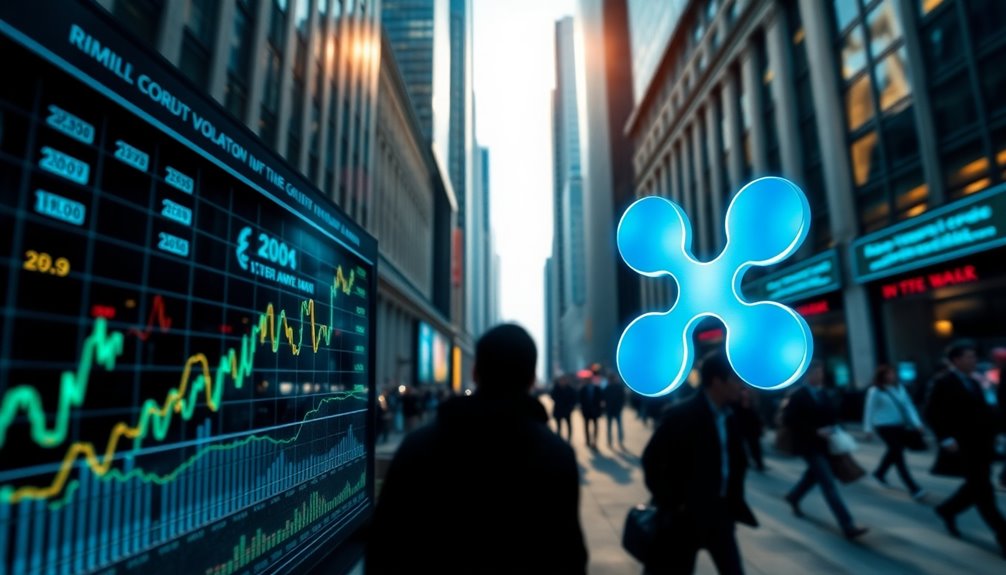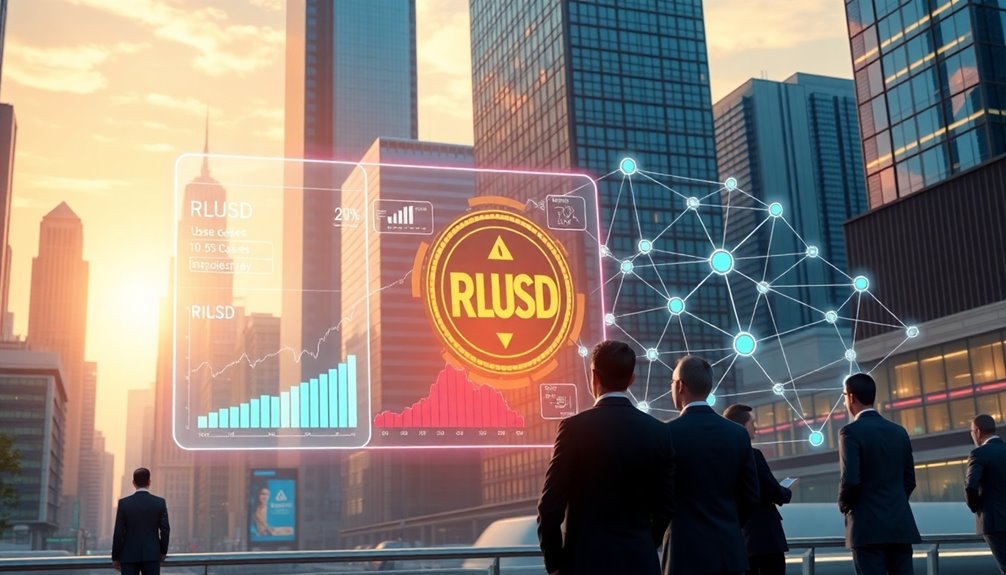Ripple's approval of its stablecoin, RLUSD, could send shockwaves through the monetary system. With a backing strategy that exceeds 100% and strict regulatory compliance, RLUSD stands poised to gain traction in the $172.8 billion stablecoin market. As Ripple aims to stabilize XRP's price fluctuations, the move enhances trust and boosts institutional adoption. With growing competition and a push for efficient cross-border payments, RLUSD may well disrupt traditional financial systems like SWIFT. The evolving landscape suggests Ripple's stablecoin is just the beginning of a significant shift in how we perceive digital currencies and their place in finance.
Key Takeaways
- Ripple's RLUSD is backed by regulated assets, enhancing market credibility and potentially stabilizing XRP's price fluctuations in a volatile market.
- The approval of RLUSD reflects compliance with strict regulations, setting a precedent for other stablecoins and influencing future regulatory frameworks.
- With a projected stablecoin market growth, RLUSD could disrupt traditional payment systems, competing with established players like Tether and USD Coin.
- The integration of RLUSD into RippleNet enhances cross-border payment efficiency, appealing to businesses and consumers, thereby reshaping transaction landscapes.
- Increased adoption of RLUSD may challenge legacy financial systems, potentially leading to systemic shifts in the monetary framework and payment processing.
Ripple's Regulatory Journey

Ripple's regulatory journey has been marked by significant challenges and milestones that have shaped its path in the cryptocurrency landscape. The SEC filed a lawsuit against Ripple Labs on December 21, 2020, alleging that XRP was sold as an unregistered security. This classification dispute sparked a fierce argument, with the SEC claiming XRP is a security, while Ripple asserted it functions more like a currency, akin to Bitcoin and Ether.
In July 2023, Ripple scored a significant victory when U.S. District Judge Analisa Torres ruled that XRP doesn't qualify as a security. However, the victory was bittersweet, as Ripple was ordered to pay $125 million in penalties for unregistered sales to institutional investors. This ruling emphasized the importance of Ripple's utility in cross-border payments, further distinguishing it from traditional securities.
As both Ripple and the SEC continue to file appeals, the case raises critical questions about the future of digital asset regulation. The ongoing battle highlights the urgent need for clear regulatory guidelines tailored for cryptocurrencies.
As Ripple navigates this complex landscape, the implications of its legal journey could influence not just its future but also the broader cryptocurrency ecosystem and institutional participation in the market.
Features of RLUSD

When you consider RLUSD, its overcollateralization strategy stands out, ensuring that it remains fully backed by US dollar deposits and other cash equivalents. You'll also appreciate its commitment to regulatory compliance, as it prioritizes transparency and regular audits to maintain trust. Moreover, its backing is designed to mitigate depegging risks, which enhances RLUSD's reliability in the ever-evolving landscape of stablecoins.
Overcollateralization Strategy
One key feature of RLUSD is its overcollateralization strategy, which guarantees the stablecoin is backed by more than 100% of its face value in reserves. This means that for every dollar of RLUSD in circulation, there are more than a dollar's worth of cash and short-term cash equivalents held in reserve.
This overcollateralization aims to guarantee stability and trust, mitigating risks associated with market volatility. In addition, the approval from the New York Department of Financial Services signifies a strong regulatory backing that enhances confidence in the stablecoin.
The reserves consist of highly liquid assets, allowing Ripple to quickly meet redemption demands. This liquidity is essential for maintaining the stablecoin's peg to the US dollar, assuring that users can confidently transact without fear of devaluation.
Additionally, Ripple commits to regular, independent audits of these reserves, publishing monthly reports to enhance transparency.
This auditing process helps maintain user and regulatory confidence, as it provides an unbiased assessment of the reserves' health.
Regulatory Compliance Assurance
Regulatory compliance is a cornerstone of RLUSD's design, guaranteeing you can engage with confidence in a rapidly evolving market. Issued under a New York Trust Company Charter, RLUSD adheres to strict oversight from the New York Department of Financial Services (NYDFS). This level of scrutiny ensures that it meets high regulatory requirements for transparency, security, and consumer protection.
Each RLUSD token is fully backed by U.S. dollar reserves, short-term government bonds, and cash equivalents. Monthly third-party audits of these reserves enhance transparency and build trust. These regular audits set a new standard for compliance, with results published to maintain ongoing accountability. Moreover, RLUSD aims to build trust among users and institutions through its transparency and security measures.
Operating under one of the toughest regulatory frameworks, RLUSD has earned a spot on the NYDFS's "Green List," reflecting its commitment to stringent compliance. This not only raises the bar for the stablecoin market but also fosters trust among users and institutions alike.
Your confidence in RLUSD is bolstered by its partnerships with reputable payment providers like Bitstamp, MoonPay, and Uphold, legitimizing the use of blockchain in traditional finance. With RLUSD, you minimize exposure to market fluctuations and regulatory ambiguity, paving the way for a more secure digital currency experience.
The Stablecoin Market Landscape

The stablecoin market is currently dominated by a few major players, but emerging competitors are developing innovative strategies to capture market share. As regulatory frameworks evolve, you'll see how these changes can greatly impact both established and new stablecoin projects. Understanding this landscape is essential for anyone looking to navigate the future of digital currencies. The market cap of stablecoins is expanding with new entrants that are diversifying the assets backing these coins.
Current Market Dominance
As stablecoins continue to gain traction, their market landscape has evolved dramatically, showcasing a total market capitalization of $172.8 billion as of September 2024.
With this growth, stablecoins now hold a 7.89% share of the total $2.19 trillion cryptocurrency market. Over the past months, the market cap surged by 17.55%, reaching its all-time high, thanks to advancements in technology and clearer regulatory frameworks.
Tether (USDT) dominates this space with a staggering market cap of $119.18 billion, accounting for about 68.98% of the total stablecoin market. Following closely is USD Coin (USDC), holding around 20.75% with a value of $35.86 billion. Other stablecoins like DAI, FDUSD, and Athena USDe are also making their mark.
Adoption is on the rise, with stablecoin addresses increasing by 15% to 121.67 million. Total addresses holding stablecoins has reached approximately 121.67 million, further underscoring their expanding user base.
Transactions involving stablecoins have reached approximately $20.1 trillion in the last year alone, evidencing their growing role in payments, especially for cross-border transactions.
As regulatory clarity improves, the demand for stablecoins is expected to grow further, making them a critical component of the evolving financial landscape.
Emerging Competitor Strategies
Emerging competitors in the stablecoin market are rapidly adapting their strategies to capture a share of the growing demand. With stablecoins projected to become primary payment instruments by 2029, companies are keen to capitalize on this trend. The market cap of stablecoins has reached unprecedented levels, largely due to advancements in technology and clearer regulatory frameworks.
You'll notice that many new players, like Ripple with its RLUSD, are leveraging existing blockchain infrastructures to attract users. They're diversifying their collateral assets, backing stablecoins with gold, stocks, and other digital assets. This trend reduces investment risks and appeals to a broader audience.
Moreover, the technological enhancements in 2024 have made transactions faster and more cost-effective, further driving adoption. As liquidity pools in decentralized exchanges grow, participation in yield farming and lending platforms is on the rise, reflecting increased investor interest. Additionally, the significant growth in total market capitalization is expected to further boost investor confidence in stablecoin projects.
Regulatory Landscape Impact
Steering through the evolving regulatory landscape is vital for stablecoin issuers aiming to thrive in a competitive market. With the MiCA regulation effective from July 2024 in the EU, issuers must ascertain they maintain adequate reserves and provide clear redemption rights. Additionally, the regulatory focus on financial crime risks will necessitate robust compliance measures to mitigate potential liabilities.
Singapore already has a framework in place, while the UK and Hong Kong are poised to update their regulations in 2024. In the US, Ripple's RLUSD approval from the New York Department of Financial Services marks a significant regulatory milestone.
Compliance is non-negotiable; issuers must safeguard assets and prepare detailed white papers for regulatory approval. As around 80% of stablecoins now adhere to some form of regulation, the push for higher compliance rates is evident.
The stablecoin market, with a capitalization of about $165.93 billion, continues to grow, driven by increasing use in cross-border transactions and e-commerce.
Regulatory scrutiny is intensifying, particularly concerning financial crime and systemic risks. The focus on investor protection underlines the need for a secure and transparent environment.
As stablecoins evolve, adhering to these regulations will be essential for issuers to gain trust and maintain market integrity.
Competition With Established Players

While the stablecoin market is dominated by established players like Tether's USDT and Circle's USDC, Ripple's RLUSD aims to carve out a significant niche.
With the stablecoin market valued at over $196 billion, there's ample opportunity for new entrants to make their mark. However, Tether and Circle benefit from robust network effects and large user bases, creating a challenging landscape for RLUSD.
To compete effectively, RLUSD is taking a strategic approach by securing regulatory compliance through a limited-purpose trust charter from the NYDFS. This move not only aligns with industry standards but also builds trust among potential users, setting a solid foundation for growth. Additionally, Ripple is expected to obtain a limited purpose trust charter for digital asset services, which will further strengthen its position in the market.
By being pegged to the US dollar and backed by secure assets like U.S. government bonds, RLUSD aims to minimize price volatility—an essential feature for any stablecoin.
Additionally, Ripple's focus on enhanced governance, including the appointment of former FDIC chair Sheila Bair, signals its commitment to reliability and security.
As RLUSD enters the fray, it could spark innovation and elevate service standards across the entire stablecoin sector, challenging the status quo held by established competitors.
Strategic Partnerships and Access

Strategic partnerships play an essential role in the success of Ripple's RLUSD, guaranteeing its accessibility and functionality in the competitive stablecoin market. By teaming up with key exchanges and financial institutions, Ripple expands RLUSD's reach and enhances its credibility. In addition, the involvement of leading market makers such as B2C2 and Keyrock is expected to significantly boost RLUSD's liquidity.
| Partnership Type | Key Partners | Impact |
|---|---|---|
| Exchange Partners | Uphold, Bitstamp, Bitso | Global availability and accessibility |
| Institutional Collaborations | Garanti BBVA Kripto, B2C2 US | Enhanced security, performance, and liquidity |
| Regulatory Compliance | New York Department of Financial Services (NYDFS) | Trust and reliability in the market |
Exchanges like Bitso and MoonPay guarantee RLUSD's presence across multiple regions, while collaborations with Garanti BBVA Kripto and B2C2 US emphasize security and institutional support. With a strong focus on regulatory compliance, Ripple positions RLUSD as a trusted stablecoin, making it easier for businesses to adopt. The robust infrastructure and partnerships create a seamless experience for users, allowing RLUSD to thrive in the evolving financial landscape.
Use Cases for RLUSD

When you consider the use cases for RLUSD, think about the efficiency it brings to cross-border payments. It not only streamlines transactions but also attracts institutional adoption by offering a stable alternative for global financial operations. With RLUSD, you can experience faster, more reliable transfers that cut down on costs and wait times. This stablecoin is backed by cash reserves and equivalent instruments, ensuring security and stability for users during transactions.
Institutional Adoption Benefits
Ripple's RLUSD stablecoin offers significant benefits for institutional adoption, positioning itself as a powerful tool for banks, investment funds, and financial institutions.
Exclusively available to institutional investors, RLUSD meets strict regulatory and security standards, ensuring compliance with NYDFS guidelines. This focus on regulatory compliance enhances trust, making it an appealing option compared to other stablecoins like USDC and USDT. Furthermore, with over 10 million RLUSD minted on the XRP Ledger, the demand for this stablecoin is clearly gaining traction. Additionally, navigating regulatory compliance is crucial for institutions looking to leverage digital assets effectively.
With RLUSD being 100% backed by US dollar reserves, you can count on its stability and transparency.
Ripple plans to provide monthly reserve reports, giving you peace of mind through regular updates on the stablecoin's backing. The auditing mechanisms in place further enhance security, allowing you to track and verify reserve assets easily.
Cross-Border Payment Efficiency
As cross-border transactions become increasingly essential in today's global economy, RLUSD stands out for its ability to streamline these payments. With the XRP Ledger facilitating near real-time settlements, you can send money anywhere in the world in just seconds. This speed markedly enhances the efficiency of global remittances and payments, cutting down the need for multiple intermediaries and minimizing transaction time. Additionally, RLUSD offers low transaction fees compared to traditional systems, making it ideal for daily use and microtransactions. By eliminating fees tied to intermediary banks, you'll find it a cost-effective solution, especially if you're a small to medium-sized enterprise looking to expand globally.
Moreover, RLUSD employs advanced blockchain technology to guarantee secure and transparent transactions. You get real-time tracking for full visibility over your funds, minimizing risks of fraud while ensuring compliance with regulations. This commitment to security is further strengthened by the platform's advanced security features, which protect user funds and prevent fraud.
With its global reach and availability on multiple networks, RLUSD not only enhances liquidity for large transactions but also integrates seamlessly into various DeFi applications. This combination of speed, cost-efficiency, and security positions RLUSD as a game-changer in cross-border payment solutions.
Impact on XRP Volatility

The introduction of RLUSD could help calm the storm of volatility surrounding XRP, offering a more stable alternative for investors.
Currently, XRP's price swings dramatically, largely due to the ongoing SEC lawsuit that classifies it as an unregistered security. This legal uncertainty contributes to significant price fluctuations, making it challenging for you to predict market movements confidently. The implementation of smart contracts could further enhance the functionality and security of transactions involving the stablecoin. Additionally, the stablecoin's backing by regulated assets could further enhance its credibility in the market.
With RLUSD in the mix, you may find that investor sentiment stabilizes, as the stablecoin provides a predictable option against XRP's erratic behavior. As XRP gained over 17% following updates on stablecoin and ETF approval, it indicates a positive shift in market perception.
If XRP breaks above the $1.96 resistance level, it could see a further price rally exceeding 30%, but the Relative Strength Index (RSI) suggests that prices are overheated.
A drop below $1.35 could invalidate the current bullish outlook, adding to the uncertainty.
Broader Financial Market Effects

Maneuvering the stablecoin landscape is set to become more dynamic with the introduction of RLUSD, which could reshape broader financial market effects. Ripple's entry into this competitive arena places it alongside established players like Circle and Paxos, potentially accelerating the growth of the market, currently valued at over $196 billion. As more fintech firms join the fray, you're likely to see a surge in adoption, driven by RLUSD's efficiency in cross-border payments and remittances. Additionally, RippleNet facilitates efficient cross-border transactions, which may further enhance the appeal of RLUSD among businesses and consumers alike.
Here's how RLUSD might affect the broader financial market:
| Market Aspect | Impact of RLUSD |
|---|---|
| Market Competition | Increased rivalry with existing issuers |
| Transaction Efficiency | Reduced costs and faster transactions |
| Institutional Adoption | Enhanced trust among institutional clients |
| Regulatory Compliance | Higher standards across the industry |
| Global Trends | Alignment with international regulations
Regulatory Implications for Crypto

Regulatory implications for crypto are becoming increasingly complex and essential as the market evolves. With significant developments like Ripple's RLUSD stablecoin, you need to stay informed about the shifting landscape.
The U.S. Treasury's recommendations for a federal framework and the President's Working Group's push for stablecoin issuance to be limited to insured institutions signal major changes ahead.
Here are key points to take into account:
- Compliance with KYC and AML regulations is mandatory, but varies widely across jurisdictions.
- Non-compliance can lead to hefty fines and possible criminal charges.
- Ripple is currently maneuvering through the approval process with the New York Department of Financial Services (NYDFS) for its stablecoin.
- Algorithmic stablecoins face prohibition in certain areas, like under the EU's MiCA regulations.
- Trust companies need specific approvals for each blockchain they operate on.
As these regulatory frameworks take shape, stakeholders must establish clear protocols to ensure adherence to compliance will be vital for any crypto-related activities.
The landscape will continue to evolve, making it essential for you to adapt quickly to avoid pitfalls and leverage future opportunities.
Future of Stablecoins in Finance

Stablecoins are poised to reshape the future of finance by offering a bridge between traditional banking systems and the growing blockchain ecosystem. With a market valuation hitting $169 billion and a 29% increase in supply by August 2024, their influence is undeniable. Major players like PayPal are integrating stablecoins, which shows their increasing adoption. Additionally, the stablecoin market has seen a significant increase in trading volume and market cap, indicating robust interest from investors and institutions alike.
Here's a quick look at key aspects of stablecoins:
| Aspect | Details |
|---|---|
| Market Growth | Over $40 billion worth of new stablecoins issued in 2024. |
| Technological Infrastructure | Advanced blockchain platforms guarantee scalability and security. |
| Integration with Finance | Seamless interaction with fiat currencies enhances utility. |
| Market Competition | Tether (USDT) and USD Coin (USDC) dominate 90% of the market share. |
As you can see, stablecoins are becoming integral to both digital and traditional finance. Their ability to provide price stability and reduce risks makes them appealing. With continuous innovations and partnerships, the future looks bright, potentially displacing legacy systems like SWIFT and Visa, while driving global adoption and reshaping financial landscapes.
Frequently Asked Questions
What Is the Significance of the NYDFS Approval for RLUSD?
The NYDFS approval for RLUSD is essential because it legitimizes Ripple's entry into the stablecoin market.
Without this approval, you can't launch the stablecoin, which means you miss out on capturing a share of the growing $200 billion market.
It also guarantees compliance with key regulations, boosting confidence among users and investors.
Ultimately, this approval paves the way for greater integration of stablecoins into the financial system, impacting how you transact.
How Does RLUSD Ensure Its Overcollateralization?
When it comes to ensuring overcollateralization, RLUSD's got you covered.
You'll deposit assets that exceed the value of the stablecoins you mint, creating a robust safety net. Smart contracts manage the collateralization ratio, pulling in diverse assets from cryptocurrencies to traditional ones.
If the collateral value dips, automatic liquidations kick in, auctioning off assets to maintain stability. This structured approach keeps your investment secure, ensuring peace of mind in a volatile market.
Will RLUSD Have Any Transaction Fees for Users?
Yes, RLUSD will have transaction fees, but they're minimal.
You'll find them considerably lower than traditional cross-border transfer systems, similar to XRP transactions, which are nearly free.
These fees exist mainly to prevent spam and guarantee network security, not to generate revenue.
Occasionally, during high congestion, fees might increase to prioritize urgent transactions, but overall, you'll benefit from low costs, making RLUSD ideal for daily use and microtransactions.
What Measures Are in Place to Prevent Fraud With RLUSD?
Imagine you're a small business owner who just discovered a fraudulent transaction draining your resources.
To prevent such incidents with rlusd, advanced technology like AI and machine learning detects anomalies in real-time.
You'll also benefit from multi-layered detection methods and biometric authentication, ensuring only authorized personnel access sensitive information.
Additionally, robust internal controls, regular audits, and an incident response plan help safeguard your finances, allowing you to focus on growing your business securely.
How Will Rlusd's Launch Affect Existing Stablecoins?
RLUSD's launch will shake up the stablecoin market, pushing existing players like USDT and USDC to enhance their transparency and regulatory compliance.
You'll likely see increased competition, which could lead to innovations and improved services across the board.
As institutions show more interest in stablecoins, RLUSD's entrance might attract new users, forcing others to adapt or risk losing market share.
This could ultimately benefit you as a consumer through better options and trustworthiness.
Conclusion
To summarize, Ripple's RLUSD could be a financial game-changer, shaking the very foundations of the monetary system. As it carves its niche in the stablecoin market, you'll want to keep a close eye on how it challenges established players and sparks new partnerships. This isn't just another crypto tale; it's a potential revolution that could redefine the future of finance. Buckle up, because the ride ahead might just be a wild one!










